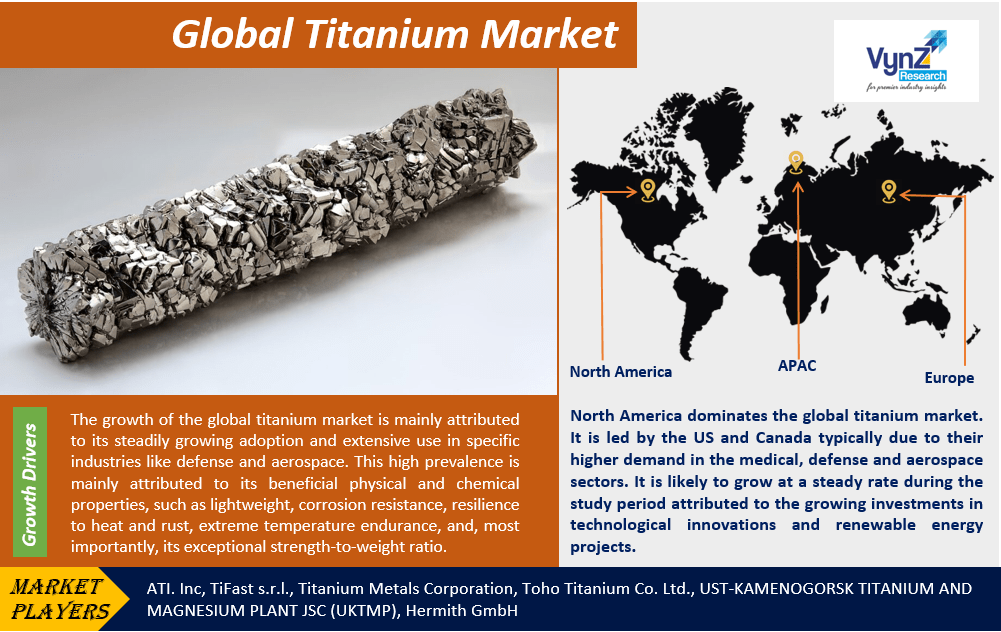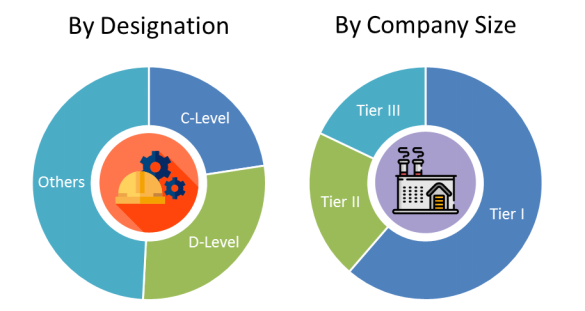Industry Overview
The Global Titanium Market size was valued at USD 26.5 billion in 2025. It is likely to grow up to USD 39.2 billion by 2035 at a CAGR of 6.8% during the forecast period ranging between 2026 and 2035. The medical sector plays a significant role in the growth of the market.

This is because the applications of titanium in this specific sector have increased manifold in the past few years and are expected to grow even more during the projected period. This metal is usually used for applications like medical implants, but it is also used in other devices such as surgical tools. Ideally, the high non-toxic and biocompatible properties of titanium make it the most appropriate metal to use in these devices, dental implants, artificial bones, and joint replacements. Titanium metal is light in weight but is very strong and does not rust. It is usually found in soil and rocks and processed meticulously to get this silvery-grey metal, which is resistant to corrosion and heat. This metal is used for various applications where toughness and functionality are the primary requirements. Generally, in the tech field, this tough metal is used to make rockets, ships and airplanes. It is also used to make different sports equipment, buildings, cars, and even jewelry. However, it is used extensively in the medical field, as explained earlier, because it is safe to use inside the body.
Global Titanium Market Report Coverage
|
Report Metric
|
Details
|
|
Historical Period
|
2020 - 2024
|
|
Base Year Considered
|
2025
|
|
Forecast Period
|
2026 - 2035
|
|
Market Size in 2025
|
U.S.D. 26.5 Billion
|
|
Revenue Forecast in 2035
|
U.S.D. 39.2 Billion
|
|
Growth Rate
|
6.8%
|
|
Segments Covered in the Report
|
By Microstructure, By Metal Type, By Product Type, By End User
|
|
Report Scope
|
Market Trends, Drivers, and Restraints; Revenue Estimation and Forecast; Segmentation Analysis; Impact of COVID-19; Companies’ Strategic Developments; Market Share Analysis of Key Players; Company Profiling
|
|
Regions Covered in the Report
|
North America, Europe, Asia Pacific and Rest of the World
|
Global Titanium Industry Dynamics
Global Titanium Market Trends/ Growth Drivers:
Steady growth in adoption and use in the defense and aerospace sectors
The growth of the global titanium market is mainly attributed to its steadily growing adoption and extensive use in specific industries like defense and aerospace. This high prevalence is mainly attributed to its beneficial physical and chemical properties, such as lightweight, corrosion resistance, resilience to heat and rust, extreme temperature endurance, and, most importantly, its exceptional strength-to-weight ratio. These properties make titanium an ideal metal for military vehicles where strength and reliable performance are crucial, encouraging governments to increase defense funding to use this metal for vehicle building, thereby increasing demand and market growth. In the aerospace sector, this metal is typically used to make spacecraft and airplanes due to its lightweight nature. It reduces the weight of the aircraft as a whole. This eventually helps in reducing the consumption of aviation fuel, which is expensive, and reduces the cost of operation. The demand for titanium in this sector is expected to grow significantly in the study period due to the significant rise in air travel, which will drive the demand for more airplanes and therefore boost the manufacturing of airplanes and demand for titanium.
A few other specific factors that drive the growth of the market include growing adoption in the automotive sector to build electric vehicles for higher efficiency and sustainability compliance, in the construction industry for its durability and strength, in the chemical sectors due to its corrosion resistance even to harsh chemicals, in luxury goods sectors to make jewelry and watches, growing urbanization drives in developing countries, rapid technological developments, and higher emphasis on a focus on offshore wind turbines and other green energy projects.
Global Titanium Market Challenges
High cost of production and inadequate availability of raw materials
It takes a lot of money, energy, and labor to produce titanium as extracting the ore and processing it to get titanium eventually is a complex process. This significant challenge hinders the growth of the global titanium market. This makes the process very expensive, thereby increasing the overall price. In addition, the inadequate supply of raw materials causes delays in production. This titanium ore is mainly available in a few particular regions. Furthermore, the lack of adequate suppliers for it, along with the issues in the supply chain, add to the scarcity, which eventually affects its cost. Both these deter cost-sensitive sectors adopt and use titanium for their production purposes. Other growth challenges include stiff competition from carbon and aluminum composites and other alternative materials, growing concerns over environmental impact and issues with mining titanium ore and processing, technical complexities in machining the metal, and a need for professional expertise and specialized tools.
Global Titanium Market Opportunities
Growing adoption and use in the electric vehicles sector
The rising adoption and use of titanium in the electric vehicle sector to increase functionality and reduce the weight of vehicles is a significant factor that presents novel growth opportunities to the global titanium market. This is mainly attributed to the properties of titanium that help reduce battery load and increase its range. Furthermore, the growing initiative by the government to promote green transportation also fuels the demand for EVs and the rise in their production, thereby increasing the demand and adoption of this metal in this sector. Also, higher applicability in renewable energy sectors, manufacturing of solar panel frames and wind turbines, rapid industrial and infrastructural development initiatives in developing markets, innovations and tech development to reduce the cost of production present significant growth prospects.
Recent Development by Key Players
Toho Titanium Co. Ltd. has expanded its titanium sponge production capacity by adding 3,000 tons of annual production capacity. The company has planned to improve its domestic facilities in Japan and construct a new production facility.
ATI.Inc. which is an U.S.-based manufacturing company, has expanded its titanium melting operations at Richland, Washington, to increase the production capacity that is due to the rising demand for titanium metal in the aerospace & defense industry.
Global Titanium Market Segmentation:
VynZ Research provides an analysis of the key trends in each segment of the Global Titanium Market report, along with forecasts at the regional and country levels from 2026-2035. Our report has categorized the market based on Microstructure, Metal Type, Product Type and End User.
Insight by Microstructure
- Alpha
- Near-alpha Alloy
- Alpha-beta Alloy
- Beta Alloy
Alpha-beta alloys segment dominates due high strength and versatility
The global titanium market is divided by microstructure into Alpha and Near-alpha Alloy, Alpha-beta Alloy, and Beta Alloy segments. Out of these three segments, the alpha-beta alloys segment dominates the market due to its higher strength and versatility, which are balanced perfectly with ductility. The increasing demand for lightweight materials for better energy efficiency will also fuel the growth of this particular segment in the forecast period.
Insight by Metal Type
- Industrial Grade
- Medical Grade
- Others
Industrial grade titanium segment dominates due to higher share
Different metal types also divide the global titanium market into Industrial Grade, Medical Grade, and other segments. Out of all these segments, the industrial grade titanium segment dominates the market due to its higher share and applicability across a wide range of industries such as automotive, aerospace, and construction. Rising industrialization drive promises further growth of this segment in chemical plants, infrastructure, manufacturing, and offshore structures.
Insight by Product Type
- Titanium Dioxide
- Titanium Metal
Titanium Dioxide segment dominates due to widespread adoption
According to the product type, the global titanium market is divided into Titanium Dioxide and Titanium Metal segments with the former dominating the market due to widespread adoption and higher applicability in paints, plastics, coatings, and cosmetics attributed to its extraordinary UV resistance and opacity that helps in improving durability of products. It also ensures top-quality finishes in the construction and automotive sectors, thereby increasing its demand and growth further.
Insight by End User
- Chemicals
- Paints & Coatings
- Rubber & Plastic
- Power & Energy
- Defense & Aerospace
- Others
The aerospace & defense segment dominates being the largest consumer
The global titanium market is segregated by different end users into Chemicals, Paints & Coatings, Rubber & Plastic, Power & Energy, Defense & Aerospace, and other segments. Out of them all, the aerospace & defense segment dominates the market, being the largest consumer. The corrosion resistance, strength, and lightweight properties of titanium metal ensure the efficiency and safety of engines, airframes and military vehicles.
Global Titanium Market: Geographic Overview
- North America
- Europe
- Germany
- U.K.
- France
- Italy
- Spain
- Russia
- Rest of Europe
- Asia-Pacific (APAC)
- China
- Japan
- India
- South Korea
- Vietnam
- Thailand
- Malaysia
- Rest of Asia-Pacific
- Rest of the World (RoW)
- Brazil
- Saudi Arabia
- South Africa
- U.A.E.
- Other Countries
North America dominates the global titanium market. It is led by the US and Canada typically due to their higher demand in the medical, defense and aerospace sectors. It is likely to grow at a steady rate during the study period attributed to the growing investments in technological innovations and renewable energy projects.
The Europe region will grow as well due to the robust aerospace and automotive industry and high demand. The market in Europe is typically dominated by France, Germany, and the UK due to their greater emphasis on sustainability, rising demand for lightweight materials, and increase in the number of renewable energy projects.
The Asia Pacific region is, however, expected to grow at a higher rate, with developing countries like India, China, and Japan showing huge growth prospects due to rising industrialization drives, production of EVs, and infrastructural development projects.
The market in Latin America is also expected to grow steadily, especially in Mexico and Brazil, due to steady growth in the economy, a rise in industrial and construction projects, and higher mining potential.
In the Middle East & Africa, the market growth is witnessed specifically in the infrastructure and oil & Gas sectors due to growing construction initiatives and significant energy development drives in the GCC countries.
Competitive Insights of Global Titanium Market:
PRIMARY RESEARCH INTERVIEWS - BREAKDOWN




